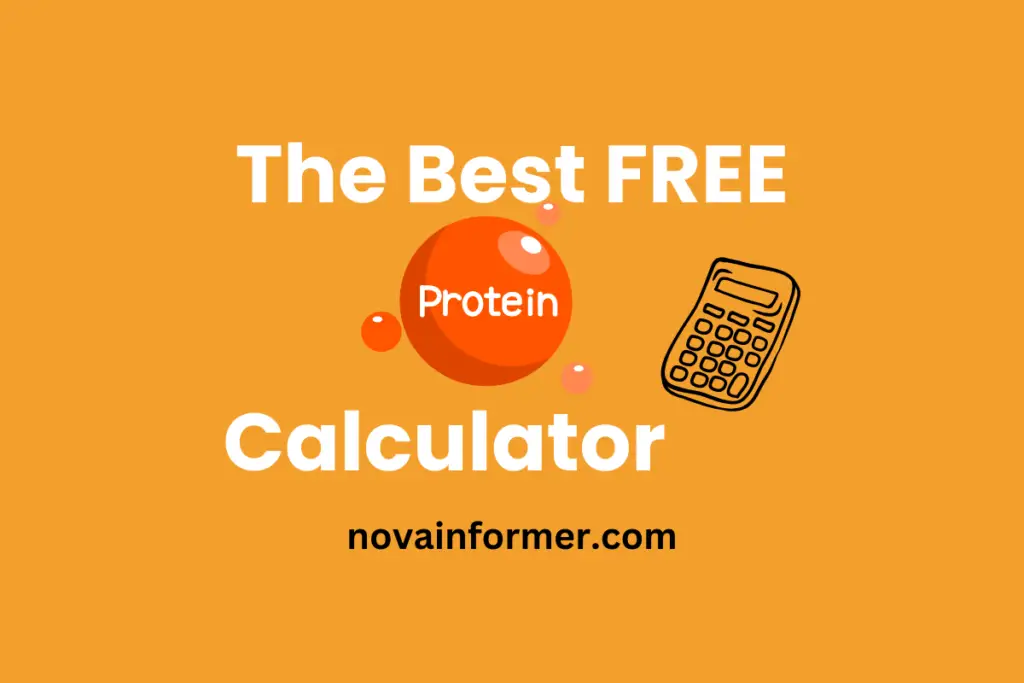This free Protein Calculator gauges your daily protein needs, ensuring a healthy and balanced nutritional journey.
Key Takeaways:
- Proteins are essential for overall health, playing a crucial role in various bodily functions.
- Understanding the types of proteins, their sources, and the science behind them is vital for optimizing your nutrition.
- Protein synthesis, muscle building, weight management, and health benefits are interconnected aspects that deserve attention.
- Special considerations, FAQs, and practical tips will help you navigate the protein landscape effectively.
Understanding Protein Basics
Introduction
Protein, the unsung hero of our nutritional story, is not just about pumping iron. It’s the silent architect behind countless bodily functions, from repairing tissues to powering our immune system. In this guide, we’ll dive into the protein universe, exploring its types, sources, digestion, and recommended daily intake.
Types of Proteins
Proteins come in different shapes and sizes, like a diverse cast in a blockbuster movie. Let’s break it down:
Complete vs. Incomplete Proteins
- Complete Proteins: Found in animal products, they contain all essential amino acids.
- Incomplete Proteins: Common in plant-based foods, lacking some amino acids.
Animal-based vs. Plant-based Proteins
| Animal-based Proteins | Plant-based Proteins |
|---|---|
| Eggs | Lentils |
| Chicken | Quinoa |
| Fish | Tofu |
Protein Sources
Think of protein sources as your nutritional Avengers – each bringing a unique superpower to the table.
- Meat: Lean cuts of chicken and turkey are protein-packed superheroes.
- Fish: Salmon and tuna are omega-3-rich knights in shining armor.
- Dairy: Greek yogurt and cottage cheese are the calcium-infused guardians.
Protein Digestion and Absorption
Digestion is the protein’s red carpet moment, turning it into amino acid celebrities. Absorption takes these VIPs to different body destinations:
- Stomach: Digestive enzymes break down proteins into peptides.
- Small Intestine: Peptides become amino acids and absorb into the bloodstream.
Recommended Daily Allowance (RDA) of Protein
A daily protein intake guide for your nutritional quest:
- General RDA: 0.8 grams per kilogram of body weight.
- Active Individuals: 1.2-2.0 grams per kilogram for muscle repair and growth.
Pro Tip: Adjust protein intake based on your lifestyle and fitness goals. A scoop of whey protein can be your protein potion post-workout.
How to Use this Protein Calculator
Welcome to our Protein Calculator, a tool designed to help you easily determine the percentage of protein in your calorie intake. Follow these simple steps to make the most out of this user-friendly tool:
Step 1: Input Your Protein and Calorie Values
- Locate the “Proteins in grams” field and enter the amount of proteins you’ve consumed.
- Move to the “Calories” field and input the total number of calories you’ve consumed.
Step 2: Click the Calculation Button
- Once you’ve entered your values, find the “Get Protein of Calories” button.
- Click the button to initiate the calculation process.
Step 3: View Your Results
- After clicking the button, the results will be displayed in the designated area.
- Your calculated protein percentage will be shown in a clear and bold format.
That’s it! With just a few clicks, you can quickly determine the percentage of protein in your calorie intake. Whether you’re monitoring your nutrition for fitness goals or simply curious about your dietary balance, this tool makes it easy and efficient.
Pro Tip: For optimal results, ensure you enter accurate values, and feel free to use this tool whenever you need a quick protein calculation.
Now, dive into the world of protein awareness and make informed decisions about your dietary choices. Stay tuned for more tools and resources to support your health and wellness journey.
Amino Acids: Building Blocks of Proteins
Essential vs. Non-essential Amino Acids
In the protein playground, amino acids are the cool kids, and there are two categories:
Essential Amino Acids
These are the amino acids that your body can’t produce on its own, so you need to get them from your diet. It’s like inviting the VIPs to a party – they must be on the guest list.
- Leucine: Found in chicken, fish, and eggs, it’s the headliner for muscle growth.
- Isoleucine: Hangs out in dairy products and nuts, supporting energy and endurance.
- Valine: Party with grains, soy, and mushrooms for overall muscle health.
Non-essential Amino Acids
These are the amino acids that your body can produce on its own. They’re the reliable pals you don’t need to invite because they’re always around.
Pro Tip: Balancing both essential and non-essential amino acids is like creating a harmonious party atmosphere in your body.
Protein Folding and Structure
Imagine proteins as tiny origami artists, folding and shaping themselves into unique structures:
Tertiary Structure
This is the three-dimensional arrangement of amino acids, creating a protein’s specific shape. It’s like a protein’s signature style – think of it as their red-carpet look.
Quaternary Structure
Sometimes, proteins team up with others to form a larger structure. It’s like a blockbuster collaboration where each protein brings its unique skill set to the table.
Side Note: Misfolded proteins can lead to health issues, similar to trying to create a complex origami structure without the right instructions.
Protein Synthesis
Welcome to the blockbuster production inside your cells – protein synthesis:
Transcription
It’s the process where the DNA code is transcribed into messenger RNA (mRNA), like the script for our blockbuster movie.
Translation
Now, the mRNA script is translated into a sequence of amino acids, forming a protein. It’s like bringing the characters to life on the big screen.
Pro Tip: Think of your balanced diet as the blockbuster script, and your body as the star cast – each nutrient playing a crucial role in the production.
Protein and Muscle Building
For those on a fitness journey, protein is your backstage pass to muscle growth:
Repair
After an intense workout, your muscles need repair. Protein swoops in like a superhero, fixing the wear and tear.
Synthesis
Amino acids, the stars of the show, stimulate muscle protein synthesis, making your muscles bigger and stronger.
Table: Essential Amino Acids for Muscle Growth | Amino Acid | Food Sources | |—————-|——————————| | Leucine | Chicken, Fish, Eggs | | Isoleucine | Dairy Products, Nuts | | Valine | Grains, Soy, Mushrooms |
Side Note: Consider a protein shake post-workout for a quick amino acid boost, aiding muscle recovery.
Protein and Weight Management
Protein is not just for the gym buffs; it’s your ally in the battle against unwanted pounds:
Satiety
Protein-rich meals keep you feeling full, reducing the temptation for extra snacks between meals.
Caloric Burn
Digesting and processing protein requires more energy, leading to more calories burned compared to fats or carbohydrates.
Side Note: Swap your morning bagel with cream cheese for a protein-packed breakfast – eggs or Greek yogurt will keep you satisfied until lunch.
Protein and Overall Health
Protein isn’t just about biceps and quads; it’s a multitasking nutrient with profound effects on our health:
- Immune Function: Amino acids from protein sources play a crucial role in building antibodies and supporting a robust immune system.
- Skin, Hair, and Nails: Protein is the beauty influencer of the nutrient world, contributing to healthy skin, luscious hair, and strong nails.
Pro Tip: For a skin-loving protein boost, incorporate fish rich in omega-3 fatty acids like salmon into your diet.
Protein Deficiency and Excess
Let’s navigate the protein maze and understand the consequences of too little or too much:
Signs of Protein Deficiency
- Fatigue: A lack of protein can lead to muscle fatigue and weakness.
- Hair Loss: Insufficient protein may result in hair thinning and loss.
- Edema: Swelling in the hands, feet, or abdomen may indicate a protein deficiency.
Risks of Excessive Protein Intake
- Kidney Strain: High protein diets may strain the kidneys over time.
- Digestive Issues: Excessive protein can lead to digestive discomfort.
- Heart Health: Some high-protein foods may come with saturated fats, impacting cardiovascular health.
Side Note: Strike a balance – neither too little nor too much. Your body is a precision machine; treat it accordingly.
Protein and Chronic Diseases
Protein plays a pivotal role in preventing and managing chronic diseases:
- Diabetes: Protein helps stabilize blood sugar levels and supports insulin function.
- Cardiovascular Diseases: Certain proteins, like those found in fish, contribute to heart health.
Table: Protein-Rich Foods for Heart Health | Food | Protein Content | Additional Benefits | |—————–|—————–|—————————-| | Fatty Fish | High | Omega-3 Fatty Acids | | Nuts and Seeds | Moderate | Healthy Fats, Fiber | | Legumes | Moderate | Fiber, Low in Saturated Fat|
Special Considerations for Certain Groups
Protein needs vary, and certain groups require special attention:
Children, Pregnant Women, and Older Adults
- Children: Essential for growth and development. Include sources like dairy, eggs, and lean meats.
- Pregnant Women: Crucial for fetal development. Incorporate poultry, beans, and leafy greens.
- Older Adults: Important for muscle maintenance. Opt for sources like yogurt, fish, and lean poultry.
Vegetarian and Vegan Diets
- Plant-based Proteins: Tofu, legumes, quinoa, and soy products provide essential amino acids.
- Supplementation: Consider vitamin B12 and iron supplements for complete nutrition.
Pro Tip: Blend legumes and grains for a complete protein punch in vegetarian meals.
FAQs
What are the best sources of protein?
A diverse range is key. Include lean meats, fish, dairy, legumes, and plant-based proteins like tofu and quinoa.
How much protein do I need daily?
It varies. General guideline is 0.8g/kg body weight, but active individuals may need 1.2-2.0g/kg for muscle growth.
Can you get enough protein on a plant-based diet?
Absolutely. Legumes, tofu, nuts, and seeds offer ample protein. Just mix and match for a complete amino acid profile.
What happens if you don’t get enough protein?
Fatigue, muscle weakness, and hair loss are signs of protein deficiency. It’s essential for overall health.
Is too much protein bad for your kidneys?
Excessive protein can strain the kidneys over time. Balance is key – aim for moderation.
Now equipped with insights into the health benefits, considerations, and FAQs surrounding protein, you’re on the path to mastering this essential nutrient.
Conclusion
Congratulations, avid reader. You’ve embarked on a protein-packed journey, uncovering the mysteries behind this essential nutrient. From the basics of protein types and digestion to the intricate dance of amino acids and protein folding, you’ve navigated the science with finesse.
As we wrap up this comprehensive guide, keep in mind that protein is not just a nutrient; it’s your ally in the journey of health and wellness.
Strike a balance, embrace a diverse protein palette, and remember, your body is a masterpiece – treat it with the nutrition it deserves.
Armed with knowledge, practical tips, and answers to burning FAQs, you’re now equipped to make informed choices about your protein intake. Whether you’re a fitness enthusiast, a plant-based warrior, or someone just seeking a healthier lifestyle, protein is your ally, cheering you on from the cellular stage to the realms of overall well-being.
Stay tuned for more insightful guides, tips, and nutritional adventures. Until then, keep savoring the goodness that protein brings to your plate, and let the journey toward a healthier you continue.
References:
License:
by Sahar Soffer (https://codepen.io/sahar-soffer/pen/NWNEZLV)



